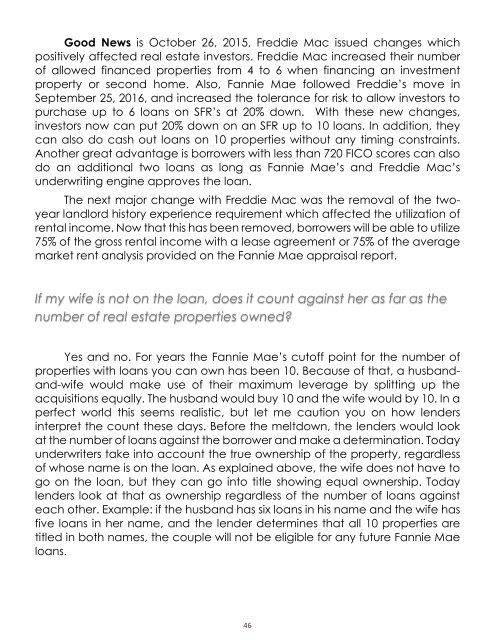You also want an ePaper? Increase the reach of your titles
YUMPU automatically turns print PDFs into web optimized ePapers that Google loves.
Good News is October 26, 2015, Freddie Mac issued changes which<br />
positively affected real estate investors. Freddie Mac increased their number<br />
of allowed financed properties from 4 to 6 when financing an investment<br />
property or second home. Also, Fannie Mae followed Freddie’s move in<br />
September 25, 2016, and increased the tolerance for risk to allow investors to<br />
purchase up to 6 loans on SFR’s at 20% down. With these new changes,<br />
investors now can put 20% down on an SFR up to 10 loans. In addition, they<br />
can also do cash out loans on 10 properties without any timing constraints.<br />
Another great advantage is borrowers with less than 720 FICO scores can also<br />
do an additional two loans as long as Fannie Mae’s and Freddie Mac’s<br />
underwriting engine approves the loan.<br />
The next major change with Freddie Mac was the removal of the twoyear<br />
landlord history experience requirement which affected the utilization of<br />
rental income. Now that this has been removed, borrowers will be able to utilize<br />
75% of the gross rental income with a lease agreement or 75% of the average<br />
market rent analysis provided on the Fannie Mae appraisal report.<br />
If my wife is not on the loan, does it count against her as far as the<br />
number of real estate properties owned?<br />
Yes and no. For years the Fannie Mae’s cutoff point for the number of<br />
properties with loans you can own has been 10. Because of that, a husbandand-wife<br />
would make use of their maximum leverage <strong>by</strong> splitting up the<br />
acquisitions equally. The husband would buy 10 and the wife would <strong>by</strong> 10. In a<br />
perfect world this seems realistic, but let me caution you on how lenders<br />
interpret the count these days. Before the meltdown, the lenders would look<br />
at the number of loans against the borrower and make a determination. Today<br />
underwriters take into account the true ownership of the property, regardless<br />
of whose name is on the loan. As explained above, the wife does not have to<br />
go on the loan, but they can go into title showing equal ownership. Today<br />
lenders look at that as ownership regardless of the number of loans against<br />
each other. Example: if the husband has six loans in his name and the wife has<br />
five loans in her name, and the lender determines that all 10 properties are<br />
titled in both names, the couple will not be eligible for any future Fannie Mae<br />
loans.<br />
46


